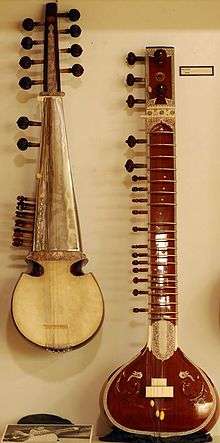Gamaka (music)
Gamaka, also known as gamak or gamakam, refers to ornamentation that is used in the performance of Indian classical music.[1] Gamaka is any graceful turn, curve or cornering touch given to a single note or a group of notes, which adds emphasis to each raga's individuality.[2] The unique character of each raga is given by its gamakas, making their role essential rather than decorative in Indian music.[3] Nearly all Indian musical treatises have a section dedicated to describing, listing and characterising gamakas.[4]
The term "gamaka" itself means "ornamented note" in Sanskrit.[4] Gamakas involve the variation of pitch of a note, using heavy forceful oscillations between adjacent and distant notes.[5] Each raga has specific rules on the types of gamakas that might be applied to specific notes, and the types that may not.
Various commentators on Indian music have mentioned different numbers of gamakas. For example, Sarangdeva describes fifteen gamakas, Narada in Sangeeta Makaranda describes nineteen gamakas, and Haripala in Sangeet Sudhakar describes seven gamaks.[6]
Types of gamakas
Carnatic music gamakas
Carnatic music has ten ornamentation classes, divided into three major groups:[7][8]
| Carnatic Ornamentation Category | Western music Equivalent | Subtypes |
|---|---|---|
| Jaaru/Ulasita | Slides | Irakka-jaru - descending slide, Etra-jaru - ascending slide |
| Gamaka | Deflections | Nokku - stress from above on successive (non-repeated) tones,
Odukkal - stress from below on successive (non-repeated) tones, Kampita - oscillation, Orikai - momentary flick, at the end of the main tone, to a higher tone |
| Janta | Fingered Stresses |
Ravai - turn from above, Sphurita - stress from below on repeated tones, Pratyahata - stress from above on repeated tones, Khandippu - sharp dynamic accent |
Hindustani music gamaks
Hindustani music has five gamakas in modern time. like- aandolan, kampita, khatkaa or gadgadita or jamjamaa, murki and sfurita.
In Hindustani Music, the gamak is similar to meend and andolan.
Gamakas in music notation
Notation of gamakams is generally not found in the Indian music system. There can be considerable difficulty in conveying the complex and fluid melodic movement of gamakas in a notation system that uses fixed pitch signs.[9] In Carnatic music in particular, the notation of gamakas is often unnecessary, as performers use notation as a memory aid for compositions they already learned by hearing and imitating.[9]
However, there are some old scripts and books like the Sangeetha Sampradaya Pradarshini, which have specific signs to indicate the gamakams that have to be used for each note. Usage of such symbols makes it easier to understand the notation and to sing the composition.
Notes
- ↑ Kassebaum (2000), p93
- ↑ Prof. P Sambamoorthy (2005), South Indian Music - Vol I, Chennai, India: The Indian Music Publishing House, p. 18
- ↑ Viswanathan, T (1977). "The Analysis of Rāga Ālāpana in South Indian Music". Asian Music. 9 (1): 13–71. doi:10.2307/833817.
- 1 2 Powers, Harry S. (1958). "Mode and Raga". The Musical Quarterly. 44 (4): 448–460. doi:10.1093/mq/xliv.4.448.
- ↑ Introduction to Gamak at the ITC Sangeet Research Academy
- ↑ Menon, Raghava R. (1995). The Penguin Dictionary of Indian Classical Music. Penguin Books (India) Ltd. p. 61. ISBN 0-14-051324-8.
- ↑ http://www.gswift.com/article-2.html
- ↑ http://www.gswift.com/article.pdf
- 1 2 Swift, Gordon (1990). "South Indian "Gamaka" and the Violin". Asian Music. 21 (2): 71–89. doi:10.2307/834112.
References
- Kassebaum, Gayathri Rajapur. ‘Karnatak raga’ (2000). In Arnold, Alison. The Garland Encyclopedia of World Music. New York & London: Taylor & Francis.
